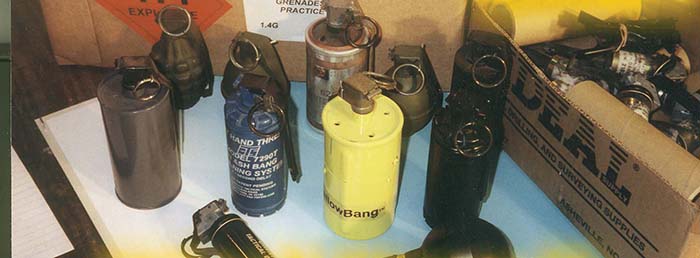An assortment of live diversionary devices, training devices and fragmentation grenades.
by Jonathan Glazer
Most aspects of our modern life are shaped by, of all things, litigation. Things like playground design and the types of dogs people keep are more influenced by court rulings than by any other individual factor. Police tactics and equipment are no exception from this trend. Due to several recent court rulings, less lethal technologies are being made even more attractive to most police forces, if not mandatory in most cases. Not having a less lethal protocol is going to cost municipalities quite a lot in defense verdicts. There are many different levels of less lethal technology that can be deployed to save lives and dollars. The diversionary device or FlashBang is one of the more high profile less lethal tools available to the tactical officer. It is also one of the least understood and most potentially dangerous to the user.
Tactical officers like to carry several FlashBangs hanging from their web gear, not the least of which is because of the way they look. This is hardly a compelling reason to issue them. This does not mean that they do not have a valid use. The fact is that they do.
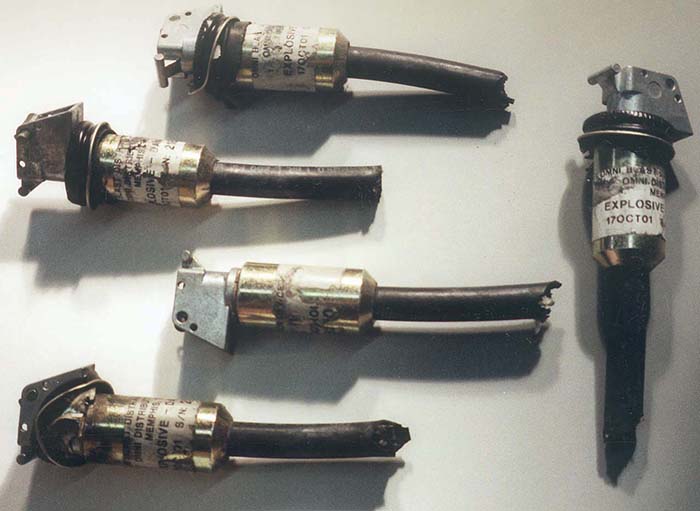
Their use dates back directly to the mid 1950’s. At that time, the U.S. Army was using explosive simulations for training purposes. Training officers would deploy these explosives, which were derived from hand grenades, in order to let recruits understand what it sounded like to be on the receiving end of explosive ordnance during combat. The first tactical use of diversionary devices was by the Israelis on 3 July, 1976 during the daring raid on the Entebbe airport in Uganda. During that highly successful engagement, the Israelis used several explosive simulators to disorient the hijackers and save the lives of many of the hostages. Other high profile uses of diversionary devices took place on 18 October, 1977 when elements of the German counterterrorist unit, GSG9 stormed a hijacked Lufthansa airliner in Mogadishu, Somalia. On 5 May, 1980 the British SAS stormed the Iranian Embassy in London. Again, the team that stormed the embassy used diversionary devices and this resulted in hostages’ lives being saved. After these promising first uses of the devices, many other police agencies began looking into adopting similar tools. A wave of technological research was undertaken to improve the utility of diversionary devices. That trend continues today as new products are continually being introduced.
Current law enforcement tactical doctrine calls for the use of diversionary devices only under certain circumstances. These scenarios include barricaded suspects and hostage situations, high risk warrant service, distraction of emotionally disturbed or intoxicated individuals and any situation in which an authorized person deems such use to be necessary to safely resolve an incident. Their use minimizes the amount of force required when an individual predetermines their own destiny in a manner that would normally have a violent end. Diversionary devices should never be used solely to preserve evidence.
Diversionary devices are also known as Flash/Sound Devices and Distraction Devices, as well as FlashBangs. They are never referred to as grenades because they operate differently and also because the usual connotation of a grenade is as a device intended to cause death. This brings along a myriad of legal implications so it is best not to ever use that word when discussing a FlashBang.
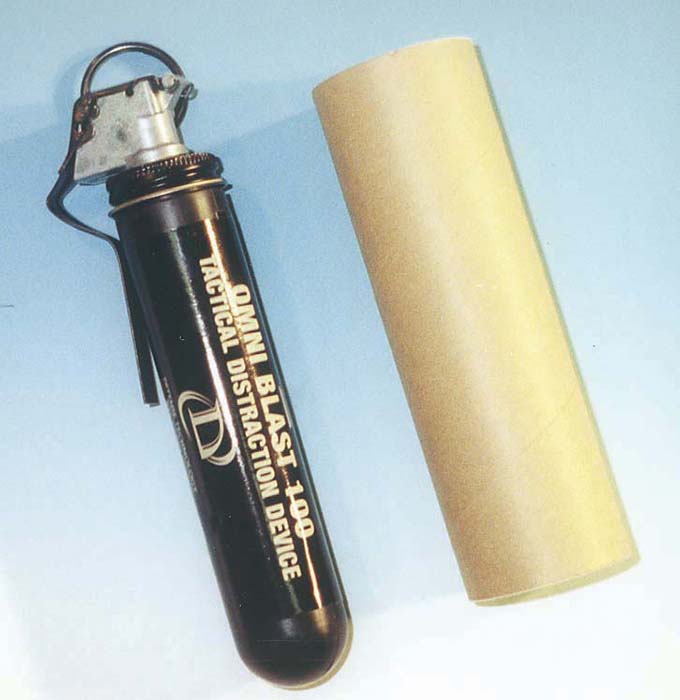
FlashBangs operate based on the initiation of an explosion of which there are three types. One is a mechanical explosion, like a balloon bursting. Another is a nuclear explosion, categorized as either fission or fusion. The third kind is a chemical explosion. There are two types of chemical explosions. One is a detonation, also known as a high order explosion. It is initiated by a shockwave and can cause sympathetic explosions of nearby explosive material. The sudden release of energy produces a shattering or breaking effect known as a brisance. These characteristics are absent from the second type of explosion which is known as a deflagration. This is the kind of explosion that is employed in a FlashBang. It is a low order explosion that is characterized by a slow burn and is dependent on the presence of oxygen. This kind of reaction is initiated by combustion. The term “slow” as used to describe the burn speed is relative considering that a typical FlashBang completes its cycle within approximately 50 thousandths of a second. Air pressure at sea level measures approximately 14.7 pounds per square inch (psi). At this pressure level at zero degrees Centigrade, the gases in a FlashBang will expand from 15 cubic inches to 33 cubic feet in 50 milliseconds. That is an increase of 3,800 times and produces a shockwave that travels 1,300 feet per second.
A device that behaves in such a way will act upon the human body in three ways and impact on three of the body’s five senses. It will produce a loud noise, which will affect the hearing. It will produce a brilliant flash, which will affect sight. It will produce an effect known as an overpressure, which will affect touch and other sensory organs. The first two effects are easy enough to understand, but it is the overpressure which is usually less familiar to most people. The bright light will do its work even through closed eyelids. It causes the pupils to contract in .5 seconds and it takes up to 2 minutes for the pupil to get back to normal. A substance called rhodopsin exists in the retina to facilitate night vision. The bright light bleaches the rhodopsin, thereby impeding night vision and it takes between 10 and 30 minutes to replenish. Ignition of the device will cause a very loud impulse noise, defined as lasting one second or less. It also produces a threshold shift, meaning that sound level perception is sharply altered and it will also produce a ringing in the ears which can be felt for a few hours afterwards. Permanent hearing damage typically results at 185 decibels and FlashBangs usually produce approximately 180 decibels. A 6 decibel increase doubles the amount of sound. Ambient air pressure in an enclosed area will first increase by up to 4 psi and then drop to a point that is .5 psi below the starting pressure immediately after the blast. This feeling of increased pressure followed by decreased pressure is an experience that is rarely felt by most people. The combination of all three types of inputs will result in a sensory overload due to the amount of incoming stimuli that must be handled by the body. Fear and panic are common reactions as a quick adrenaline dump induces the fight versus flight phenomenon. The natural instinct to stay alive occurs regardless of the circumstances and rules and customs that would ordinarily govern behavior are abandoned. Subjects typically scream and shout and may be unable to do much more than follow simple commands. This type of response is commonly followed by what is known as the acetylcholine effect. Acetylcholine is a chemical that is produced in the body and is associated with surrender and compliance. It is the opposite of the fight and flight reaction. Both responses in sequence make a subject much easier to apprehend because of the lack of an organized response to external threats. It is easy to see how use of a diversionary device will allow officers to gain the advantage on a barricaded suspect based on the impact on the three senses mentioned.
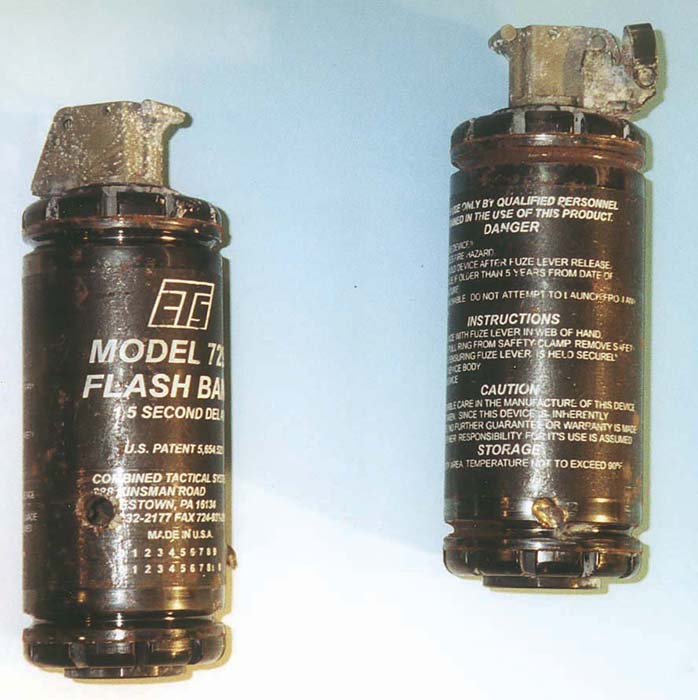
The FlashBang is composed of three main parts: The Bouchon, or fuze assembly; the body/canister and the explosive charge. The Bouchon itself is composed of three main components: The safety lever or spoon; the striker and the primer. Most FlashBangs in use today utilize the M201A1 Fuze assembly that is made by The Ensign Bickford Company. These fuze heads have a 1.5 second delay with an error range of plus or minus .5 seconds. Generally this translates into a real world delay of between .7 and 2 seconds. The body or canister is designed to protect the charge from rough handling, heat and moisture. It also contains the explosion long enough to achieve the desired effects without exceeding safe pressure levels. The charge is composed primarily of photo flash powder with a booster designed to magnify the effects of the blast. This mixture, while certainly explosive, is classified more as a propellant due to its deflagrating properties. FlashBangs are generally shaped like smoke grenades and are usually cylindrical in shape. They are meant to be thrown or carried in one hand.
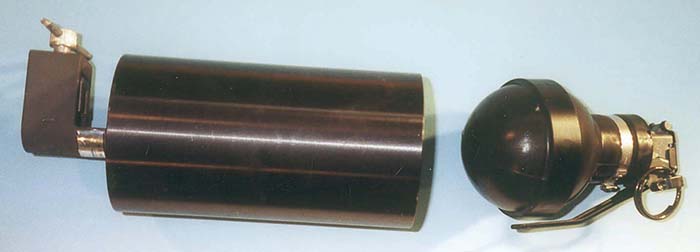
Tactical use of a FlashBang must always be specified in a written policy and taught by the designated training department. That policy should cover allowable uses as well as the correct way to utilize the device. Proper protective gear must be worn which includes eye and ear protection. It also includes the use of gloves. FlashBangs can and will cause serious injury if used incorrectly. Premature detonation due either to operator error or equipment malfunction is always a possibility. Protective gloves should be made of materials like Nomex and/or Kevlar so that they will be resistant to burning. It is also common for some departments to use cowhide welding gloves as they provide an extra level of protection. If allowed to ignite in a bare hand, FlashBangs will very efficiently remove everything from the knuckle outwards. Numerous such injuries have occurred because of not holding the spoon firmly enough, known as milking the spoon, or from switching hands or loosening one’s grip prior to tossing. If heavy protective gloves were worn during a premature ignition, there would still be significant injuries, however it is more likely that the fingers will remain attached to the hand, albeit dislocated. Another piece of gear used in conjunction with FlashBangs is an old fashioned diaper pin, usually fastened to the operator’s load bearing equipment or on their sleeve. The purpose of the diaper pin is so that if the use of the device is compromised for some reason and needs to be aborted and the split pin (described in the next paragraph) is lost, the diaper pin can be inserted into the appropriate hole and fastened, thereby securing the FlashBang in a safe manner.
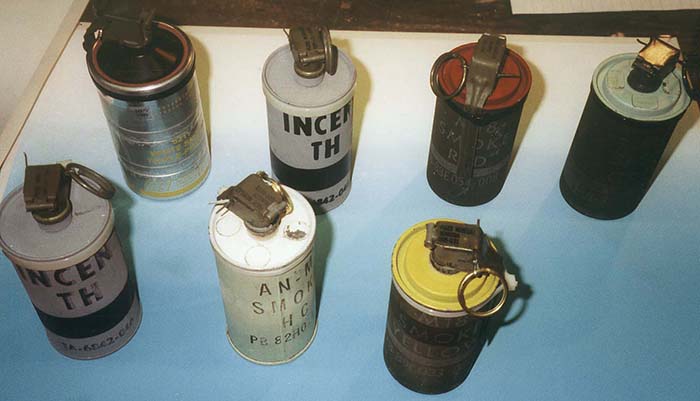
Use begins with the deployment stage, which starts with preparation of the device and ends with release of the spoon. The safety lever keeps the striker, which is driven by the striker spring, from moving forward and hitting the primer. The safety lever is held in place by a split pin that usually has both ends of the pin spread in opposite directions to prevent inadvertent removal. This pin can be left in exactly this configuration, known as hardpinning, or one or both ends can be straightened to facilitate removal. This is known as softpinning. Care must always be taken when such a procedure is undertaken. The officer deploying the device must ascertain at the scene what the proper placement for the device should be. The device must not be thrown into an area that cannot be directly observed because one of the goals of using a diversionary device is minimizing injury to bystanders. The operator must make sure there are no small children or pets or flammable materials directly in the target area. If the operator ascertains that there is an unsafe situation in the target zone, their responsibility is to abort the use of the device. One example of an unsafe condition would be the existence of open containers of flammable liquids, perhaps in a drug lab. In that situation, ignition of the device could cause combustion of the flammable materials leading to a dangerous fire. The operator should also have picked a safe spot outside the structure where a FlashBang can be quickly tossed to ignite without causing damage if an “ABORT BANG” order is issued. Going back to our abort situation, the operator should optimally reinsert the original pin to secure the device. If the original pin was lost, the diaper pin can be inserted and fastened to secure the device. If neither of those options are available, the least desirable option of tossing the device into the predetermined safe combustion zone must be taken. Once the decision to deploy is made, the device is centered in the palm of the hand with the spoon depressed firmly with the web of the hand between the thumb and forefinger. The pin is usually rotated one quarter turn to free it from the notch that holds it in place and removed. The target area is surveyed for existence of hazardous conditions and the device is tossed. Left handed operators generally will grip the device upside down as the ergonomics of the M201A1 Bouchon is designed for a right handed operator. Military training dictates that the pin on a hand grenade be pulled with the grenade held tightly into the body. This will minimize casualties in the area around the operator because the bulk of the blast and the fragments will be absorbed by the body of the operator in case of a premature detonation. In contrast, the FlashBang should be held by the hand with the arm extended. The opposing (usually the weak side) hand will pull the pin while the other hand pushes the device away. Since the FlashBang does not produce anti personnel fragments, there is less of a danger of injury to nearby personnel. By keeping the device away from the body, the explosion will minimize injury to the body of the operator. The operator’s hand will of course still be in danger of severe damage. Once the device is tossed, the ignition of the device can be interpreted by other members of the team as gunfire. The use of a FlashBang should always be brought to the attention of all members of the team so they can be properly prepared for the effects and for the next stage of the entry. The device ignition should never catch any member of the team by surprise. Deployment of the device should be accompanied by use of a readily understood short phrase, known as a brevity code. Common brevity codes are “Device in!” and “FlashBang!” as well as the military “Fire in the hole!”
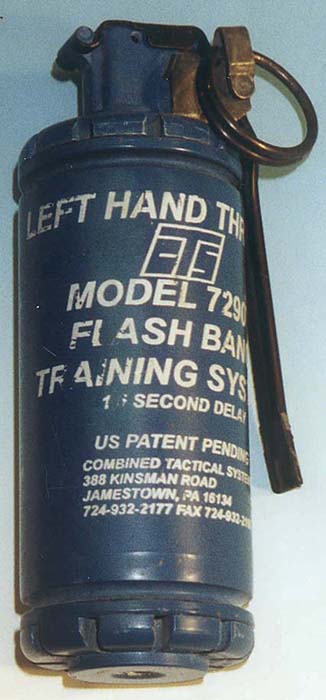
Once the spoon is released and the device is tossed, the firing sequence begins. The striker spring is allowed to propel the striker into the primer, which will be crushed and produce enough of a combustion to ignite the delay. This burns for the preset amount of time, within the error ranges typical of the Fuze. That delay is usually between .7 and 2 seconds. Since Bouchon assemblies can usually be removed from the device, care must be taken to not mix up assemblies between diversionary devices and smoke grenades. The reason this is so important is that smoke grenades typically have a zero delay and this is clearly not a desirable feature for a FlashBang.
Once the delay burns, the combustion is transferred to the main charge during what is known as the ignition sequence. The charge is made up of flash powder, which is comprised of aluminum or magnesium plus an oxidizer such as barium nitrate or potassium perchlorate. The resulting deflagration builds up inside the canister until the pressure escapes from the body of the device. The typical charge will provide 500 tons per square inch of pressure at the point of pressure. This drops off to 4-5 pounds per square inch at 5 feet from the point of ignition. The blast lasts 54 milliseconds. In contrast, an eye will take 200 to 250 milliseconds to blink. The resultant pressure wave will travel 1.136 feet in one millisecond. 40 milliseconds after ignition, the visible flash will be generated of approximately 6 million candlepower and this will last 10 milliseconds. There is very clearly a lot of energy being released in a very short amount of time.
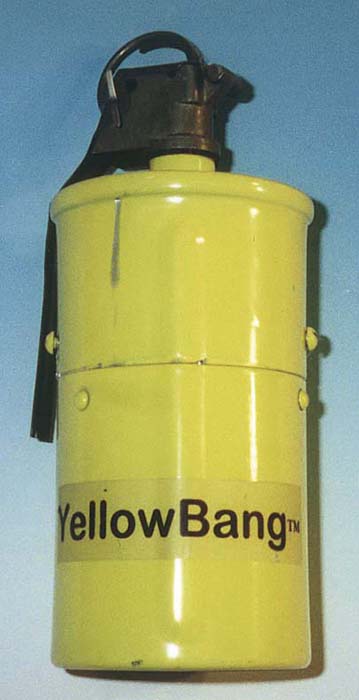
Since the purpose of the device is to minimize injuries and the possibility of death, fragmentation is not desirable. A major problem of many FlashBangs is that after ignition, the Bouchon becomes a projectile and can cause injury or death by striking a person in a vital area. FlashBang design has attempted to minimize this effect through a few different ways. One design utilizes a deflagrating canister. The Omni Blast 200 is an example of this type. The entire body of the device is destroyed by the ignition and there is no propulsion of the Bouchon as equal pressure is applied outwardly in all directions. Such canister types present the greatest danger to the operator in case of a premature detonation. Another way of dealing with this problem is by utilizing a non bursting canister. A canister of this type will be heavy and vented, allowing the plasma jets created by the ignition to escape via the vents. There will be vents in the top and bottom of the device and pressure is directed in multiple directions to minimize movement of the device. The bouchon remains attached at all times, with the exception of the spoon, which will drop free when released. Examples of these types of FlashBang are the DefTec 25 manufactured by Defense Technologies, Inc., and the ALS Diversionary Device manufactured by ALS Technologies. The latter device is notable for its use of a reusable body of either aluminum or steel. The canister can be recovered and fitted with a new fuze/charge assembly for reuse. The third type of design is the use of a submunition, which separates the bouchon from the main charge prior to ignition. Since the fuze assembly is not near the main charge, it cannot be propelled in a manner that can cause injury. This type also provides an additional level of safety in that a premature ignition will cause the submunition to eject the main charge, which will not ignite in the hand of the operator. This type represents the current direction of the industry as it has the greatest potential to minimize injuries to operators and innocent bystanders. I personally witnessed prototypes of this sort being tested by ALS Technologies and they do appear to be very effective and much safer than older FlashBang designs.
Training operators in the use of diversionary devices cannot be minimized. Improper use of a FlashBang can have severe consequences. The New York Police Department found this to be true when they effected a dynamic entry into a suspected criminal enterprise and deployed a device last year. Unfortunately, they had the wrong apartment and a lady in her 80’s suffered a fatal heart attack a few hours after being exposed to the effects of the device. There is a lawsuit pending at this time and the NYPD has implemented procedures greatly restricting the use of FlashBangs to situations that are individually approved by the Chief of Police personally. This has the effect of eliminating their use in the City of New York.
Potential operators must be trained in the operation of the devices that they will be issued. They need to know the proper circumstances in which they may be deployed and what the effects of such deployment will be, as well as how to minimize damage to property and injury to suspects, bystanders and other team members. The operator must be trained to properly use safety equipment and must know the results of not using proper equipment and procedures. There are implications for trainers to be considered as well. The cumulative exposure to FlashBangs will cause damage, even with the use of protective gear. Trainers and students should only be subjected to a maximum of 5 exposures to a FlashBang in any one day. More than 5 exposures in one day will significantly increase the chance of hearing damage. The threshold for hearing damage is 185 decibels and individual FlashBang ignitions will generally come close to that threshold, but not exceed it. Studies have shown that 1% of the population is at risk of a measurable hearing loss from one unprotected exposure. The higher frequencies are the first to go and that is the kind of hearing damage that will typically be found in cases of overexposure to diversionary devices. While this danger is certainly present, there is a greater likelihood of trainers and officers getting hearing damage from gun shots than from diversionary devices. Hearing protection is, however, unnecessary when the observer is 100 feet or more from an outdoor deployment.

There are many other factors that need to be ingrained prior to allowing an operator to tactically deploy a FlashBang. The operator needs to understand the factors that make up proper placement. 5 feet from the target is ideal as the effects from sound and pressure are optimized. As distance doubles from the device, the effects from sound and pressure are halved. The effects of barriers must be understood. Barriers can both reflect and absorb the sound and pressure depending on the composition of the barrier. Generally, softer textured barriers will absorb the effects, thereby weakening the effect of the device. More rigid materials will reflect the effects. This produces a secondary pressure wave which comes behind the initial or incident wave and produces a cumulative effect. By placing the device next to a wall, the effects will be greater than by placing it in the middle of the room due to this cumulative effect brought on by the reflection of the sound and pressure waves. The floor will reflect the sound and pressure waves up as well. A suspect will receive the same effect whether they are sitting or standing due to the reflection off of each of the surfaces in a room. Additional placement factors were touched on previously. Since temperatures in the immediate vicinity of the device will be close to 2700 degrees centigrade, the presence of laundry or newspaper or drug paraphernalia in the target zone will increase the fire hazard. Fire extinguishers must always be present and accessible by all team members when diversionary devices are being deployed. The presence of children complicates the issue since the psychological effects of the device will be exaggerated in a child. One team member needs to be assigned to be responsible for any children present at the scene. Elderly people have the risk of an increased blood pressure and pulse rate after the ignition and this could aggravate existing medical conditions. The presence of loose objects on the ground increases the likelihood that the device could propel a piece of debris with enough force to cause injury. Such a condition would not necessarily require the aborting of the deployment of the FlashBang. It might necessitate tossing of the device in an arc for an airburst.
Failure to ignite is an important issue to keep in mind. The primary reason for a failure of a FlashBang to ignite is a failure to remove the pin. While this may seem silly, it happens even to experienced officers due to stress and distraction. Occasionally, a FlashBang will malfunction and fail to ignite even when properly deployed, but modern manufacturing standards have reduced these incidents dramatically. The officer needs to be trained that if a device is deployed and it does not ignite after 2 seconds, they should simply deploy another. The likelihood of two devices failing to deploy, absent incorrect deployment, is virtually nonexistent. FlashBangs can also potentially ignite when hit by small arms fire. In tests I witnessed on DefTec 25 units, direct hits from .223 full metal jacket rounds penetrated the canister and ignited the device. Shots fired from a 9mm handgun did not penetrate the device canister and did not ignite the main charge. Clearly, care must be taken where FlashBangs are deployed or displayed, particularly in a hostile circumstance. If the spoon flipped yet the device remains unexploded, the device should never be touched directly. It should be grasped indirectly. One option is to use a long reach grabbing device to relocate the FlashBang to a “safe area”.
During training of potential users of diversionary devices, it is essential that live units be deployed. Unfortunately, FlashBangs are expensive and one can only experience up to 5 exposures per day without the danger of permanent cumulative damage. There is also paperwork that follows the devices and this makes training that much more difficult to perform. Once the student understands the effects and how to deploy a live device, there are several training aids that can be used to continue training. DefTec makes a training device which mirrors the size and weight of a DefTec 25. ALS Technologies manufactures a training unit that utilizes reusable charges to simulate a blast. CTS also makes a trainer which uses a fuze assembly with a left hand thread so that it does not inadvertently get installed on a live FlashBang. Each of these devices provide a report after a delay which does not have the same effects as a FlashBang, but is loud enough to let all participants know that the device has been deployed. Applied Tactical Technologies makes a training unit that is called the “Yellow Bang”. It utilizes a proprietary blank pistol type cartridge that is ignited thereby providing the signal report and can be cheaply and easily reloaded.
There are several alternate forms of diversionary devices other than the typical hand held FlashBang. ALS Technologies manufactures 2 different devices that can be fired from a standard 12 gauge shotgun. One is called the Bore Thunder round and is designed to be fired in any non-contact direction and aimed away from any children or flammables present at the scene. A typical deployment of such a device would be with the barrel of the shotgun projecting through a window in the target area or through a slightly opened door. The performance of this load is comparable to most hand thrown diversionary devices. The other ALS Technologies product in this category is the Aerial Burst round which is fired from the shotgun in the usual manner and delay ignites approximately 1 second after it is launched. It too is extremely effective when fired into a room through a window or a door from a distance. Care must be observed when deploying so that the projectile does not land on humans or flammables. A department that specifically will not deploy FlashBangs due to administrative rules or restrictions could deploy both devices. Utilizing such devices is no different than firing a shotgun in a tactical situation. But that is more of a legal policy decision. Similar launchable distraction devices are available for 37mm and 40mm launching devices. Alternative methods of deploying FlashBangs include putting a device on the end of a long pole to put through a window. Such a device is known either as a Flash Stick, Painter’s Pole or a Bang Pole. A Cod Weight is a heavy weight that can be attached to a diversionary device. It is designed to be thrown with force through a window or another breakable barrier where a typical FlashBang would not have enough kinetic energy to break through the barrier.
There is another device which can be deployed either in an enclosed environment or a crowd control situation. It is known as a Sting Ball device. The Sting Ball operates like a FlashBang, but it also throws out a large quantity of small high durometer rubber balls with great force. This device is generally used for crowd control, but it can be used in place of a diversionary device as well. It is a less lethal device, but the same care must be taken when using it as must be used for a FlashBang.
The FlashBang or Diversionary Device is an important less lethal tool for law enforcement. It produces a loud noise, a pressure wave, a bright flash of light and heat. These 4 characteristics affect the body’s senses of sight, hearing and feeling to provide a sensory overload on a barricaded suspect. This provides a delay of a few seconds to a few minutes during which a well trained team can gain entry, neutralize any threats and rescue any victims. Proper and effective training must be provided to all users of such devices. Formal training is paramount. Buying FlashBangs and fielding them without certified instruction is a disaster waiting to happen. A written policy must be developed and adhered to so that legal liability is minimized. Proper use of Diversionary Devices, as well as other less lethal systems, may precipitate some litigation, but it is sure to result in countless saved lives.
Contact Information
Applied Tactical Technologies
P.O Box 268
Babylon, NY 11702-0268
800 223-1204
www.att-tactical.com
ALS Technologies
1103 Central Blvd.
Bull Shoals, AR 72619
877 902-4257
www.ozarkmtns.com/less-lethal
Defense Technology
Federal Laboratories
1855 South Loop
Casper, WY 82601
877 248 -3835
www.defense-technology.com
Combined Tactical Systems, Inc.
388 Kinsman Rd.
Jamestown, PA 16134
724 932-2177
http://www.less-lethal.com/
Editor’s Note: Most distraction devices are categorized as “Destructive Devices” under Title II of the GCA-68. This requires registration and transfer through the NFRTR (NFA Branch ATF&E) and there should be a notice sent to the ATF when these items are destroyed, so they do not remain in the NFRTR. It has been suggested that there be a separate Registry for these items, because the hundreds of thousands of distraction devices now in the NFRTR, which have been destroyed and not removed, make the registry more difficult to manage.
| This article first appeared in Small Arms Review V7N11 (August 2004) |



